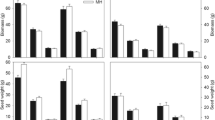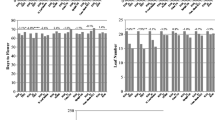Abstract
Transgenic crops can interbreed with other crop cultivars or with related weeds, increasing the potential of the hybrid progeny for competition. To prevent generating competitive hybrids, we previously tested tobacco (Nicotiana tabacum L.) as a model for validating the transgenic mitigation (TM) concept using tandem constructs where a gene of choice is linked to mitigating genes that are positive or neutral to the crop, but deleterious to a recipient under competition. Here, we examine the efficacy of the TM concept at various ratios of transgenically mitigated tobacco in competition with the wild type tobacco in an ecological replacement series. The dwarf/herbicide-resistant TM transgenic plants cultivated alone under self-competition grew well and formed many more flowers than the tall wild type, which is an indication of greater reproductivity. In contrast to the wild type, TM flowering was almost completely suppressed in mixed cultures at most TM/wild type ratios up to 75% transgenic, as the TM plants were extremely unfit to reproduce. In addition, homozygous TM progeny had an even lower competitive fitness against the wild type than hemizygous/homozygous TM segregants. Thus, the TM technology was effective in reducing the risk of transgene establishment of intraspecific transgenic hybrids at different competitive levels, at the close spacing typical of weed populations.









Similar content being viewed by others
Abbreviations
- AHAS/ahas:
-
Acetohydroxy acid synthase
- gai :
-
Gibberellic acid insensitive
- TM:
-
Transgenic mitigation/Transgenically mitigated
- WT:
-
Wild type
References
Al-Ahmad H, Gressel J (2005) Transgene containment using cytokinin-reversible male sterility in constitutive, gibberellic acid-insensitive (Δgai) transgenic tobacco. J Plant Growth Reg (in press)
Al-Ahmad H, Galili S, Gressel J (2004) Tandem constructs to mitigate transgene persistence: tobacco as a model. Mol Ecol 13:697–710
Alcocer-Ruthling M, Thill DC, Shaffi B (1992) Differential competitiveness of sulfonylurea resistant and susceptible prickly lettuce (Lactuca serriola). Weed Tech 6:303–309
Bergelson J,Purrington CB, Palm CJ, LopezGutierrez JC (1996) Costs of resistance: a test using transgenic Arabidopsis thaliana. Proc R Soc Lond Ser B-Biol Sci 263:1659–1663
Brandel JE, Miki BL (1993) Agronomic performance of sulfonylurea-resistant transgenic flue-cured tobacco grown under field conditions. Crop Sci 33:847–852
Carney SE, Hodges SA,Arnold ML (1996) Effects of differential pollen-tube growth on hybridization in the Louisiana irises. Evolution 50:1871–1878
Christianson ML (1991) Fun with mutants: applying genetic methods to problems of weed physiology. Weed Sci 39:489–496
Conard SC, Radosevich SR (1979) Ecological fitness of Senecio vulgaris and Amaranthus retroflexus biotypes susceptible or resistant to atrazine. J Appl Ecol 16:171
Daniell H (2002) Molecular strategies for gene containment in transgenic crops. Nat Biotechnol 20:581–586
De Wit CT(1960) On competition. Versl Landbouwk Onderzoek 66:1–82
Dyer WE, Chee PW, Fay PK (1993) Rapid germination of sulfonylurea-resistant Kochia scoparia L accessions is associated with elevated seed levels of branched chain amino acids. Weed Sci 41:18–22
Ellstrand NC (2003) Dangerous Liasons? When cultivated plants mate with their wild relatives. Johns Hopkins University Press, Baltimore
Gressel J (1999) Tandem constructs: preventing the rise of superweeds. Trends Biotechnol 17:361–366
Gressel J (2002) Molecular biology of weed control. Taylor and Francis, London
Gressel J, Al-Ahmad H (2005a) Assessing and managing biological risks of plants used for bioremediation, including risks of transgene flow. Z Naturforsch C (in press)
Gressel J, Al-Ahmad H (2005b) Molecular containment and mitigation of genes within crops: prevention of gene establishment in volunteer offspring and feral strains. In: Gressel J (ed) Crop ferality and volunteerism. CRC, Boca-Raton, pp 369–386
Hajdukiewicz P, Svab Z, Maliga P (1994) The small, versatile pPZP family of Agrobacterium binary vectors for plant transformation. Plant Mol Biol 25:989–994
Haldane JBS (1960) More precise expressions for the cost of natural selection. J Genet 57:351–360
Haughn GW, Smith J, Mazur B, Somerville C (1988) Transformation with a mutant Arabidopsis acetolactate synthase gene renders tobacco resistant to sulfonylurea herbicides. Mol Gen Genet 211:266–271
Hauser TP, Jorgensen RB, Ostergard H (1997) Preferential exclusion of hybrids in mixed pollinations between oilseed rape (Brassica napus) and weedy B campestris (Brassicaceae). Amer J Bot 84:756–762
Haygood R, Ives AR, Andow DA (2003) Consequences of recurrent gene flow from crops to wild relatives. Proc R Soc Lond Ser B-Biol Sci 270:1879–1886
Horsch RB, Fry JE, Hoffmann NL, Eichholtz D, Rogers SG, Fraley RT (1985) A simple and general method for transferring genes into plants. Science 227:1229–1231
Jepson I (2002) Inducible herbicide resistance. US Patent 6380463
Kuvshinov V, Anissimov A, Yahya BM (2004) Barnase gene inserted in the intron of GUS-a model for controlling transgene flow in host plants. Plant Sci 167:173–182
Maliga P (2004) Plastid transformation in higher plants. Annu Rev Plant Biol 55:289–313
Messeguer J (2003) Gene flow assessment in transgenic plants. Plant Cell Tiss Org 73:201–212
Nitsch JP (1969) Experimental and rogenesis in Nicotiana. Phytomorphology 19:389–404
Oliver MJ,Quisenberry JE, Trolinder NLG, Keim DL (1998) Control of plant gene expression. US Patent 5:723–765
Purrington CB, Bergelson J (1997)Fitness consequences of genetically engineered herbicide and antibiotic resistance in Arabidopsis thaliana. Genetics 145:807–814
Purrington CB, Bergelson J (1999) Exploring the physiological basis of costs of herbicide resistance in Arabidopsis thaliana. Am Nat 154:S82–S91
Roux F, Gasquez J, Reboud X (2004) The dominance of the herbicide resistance cost in several Arabidopsis thaliana mutant lines. Genetics 166:449–460
Saari LL, Cotterman JC, Thill DC (1994) Resistance to acetolactate synthase-inhibitor herbicides. In: Powles SB, Holtum JAM (eds) Herbicide resistance in plants: biology and biochemistry. Lewis, Boca-Raton, pp 80–139
Schernthaner JP, Fabijanski SF,Arnison PG, Racicot M, Robert LS (2003) Control of seed germination in transgenic plants based on the segregation of a two-component genetic system. Proc Natl Acad of Sci USA 100:6855–6859
Shaner DL (2002) Development and utilization of a high throughput in vivo AHAS assay. Weed Sci Soc Am Abstr 42:50
Sibony M, Rubin B (2003) The ecological fitness of ALS-resistant Amaranthus retroflexus and multiple-resistant Amaranthus blitoides. Weed Res 43:40–47
Skinner JS, Meilan R, Ma CP, Strauss SH (2003) The Populus PTD promoter imparts floral-predominant expression and enables high levels of floral-organ ablation in Populus, Nicotiana and Arabidopsis. Mol Breed 12:119–132
Stewart CN, Halfhill MD, Warwick SI (2003) Transgene introgression from genetically modified crops to their wild relatives. Nat Rev Genet 4:806–817
Tourneur C, Jouanin L,Vaugheret H (1993) Over-expression of acetolactate synthase confers resistance to valine in transgenic tobacco. Plant Sci 88:159–168
Tranel PJ, Wright TR (2002) Resistance of weeds to ALS-inhibiting herbicides: what have we learned? Weed Sci 50:700–712
Wang T, Li Y, Shi Y, Reboud X,Darmency H, Gressel J (2004) Low frequency transmission of a plastid-encoded trait in Setaria italica. Theor and Appl Genet 108:315–320
Warwick SI, Stewart CN (2005) Crops come from wild plants: how domestication, transgenes, and linkage together shape ferality. In: Gressel J (ed) Crop ferality and volunteerism. CRC, Boca-Raton, pp 9–30
Acknowledgements
Shiri Gerson, Alexandra Savitsky, Judith Karmi, and Ziv Hanan provided excellent technical assistance. We thank Dr. Dvora Aviv for her advice and help in tobacco transformation and tissue culture techniques. Dr. Roy Chaleff, American Cyanamid Company kindly provided plasmid pAC456; and Drs. Donald Richards and Nick Harberd, Department of Molecular Genetics, John Innes Centre, UK kindly provided plasmid pλ g/SK+ with the Δgai gene. This research was supported by the Levin Foundation, INCO–DC contract no. ERB IC18 CT 98 0391, and a bequest from Israel and Diana Safer.
Author information
Authors and Affiliations
Corresponding author
Rights and permissions
About this article
Cite this article
Al-Ahmad, H., Galili, S. & Gressel, J. Poor competitive fitness of transgenically mitigated tobacco in competition with the wild type in a replacement series. Planta 222, 372–385 (2005). https://doi.org/10.1007/s00425-005-1540-6
Received:
Accepted:
Published:
Issue Date:
DOI: https://doi.org/10.1007/s00425-005-1540-6




